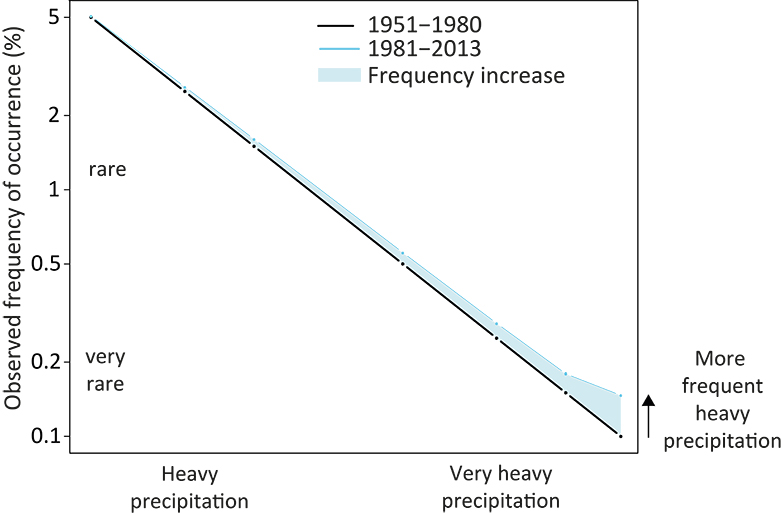In the beginning was the prediction
It often seems that climate phenomena occur unexpectedly and are explained only retrospectively. However, the relationship between rising CO2 concentration and an increase in heavy precipitation has been predicted decades ago, but not confirmed by robust observational evidence until recently.
The global warming pause or the ozone hole – climate scientists are often criticized for being surprised by environmental phenomena and able to explain the observations only after the event. [1] The fact that new findings in climate physics can also unfold the opposite way is shown by the example of extreme rainfall, where current findings confirm the predictions of researchers made 30 years ago: heavy precipitation is becoming increasingly frequent. [2]
Early theory and models
The theoretical basis for this prediction goes back to the early 19th century, when the Little Ice Age was coming to an end in Europe: Benoît Clapeyron and Rudolf Clausius recognised that warm air can hold more water vapour. As the two scientists described this relationship in physical terms, they had no idea that almost two centuries later their work would play a key role in the literature on climate change.
The first model predictions in relation to heavy rainfall were made in the 1980s, long before clear observed trends had emerged. At that time, models resolved the atmosphere into 4 to 5 vertical layers, as opposed to 80 today, with a grid size of 500 kilometres instead of 25 – so the Alps were flat and the coastlines were barely recognisable. Nevertheless, the two Japanese scientists Noda and Tokioka used the models successfully to predict that a rising CO2 concentration in the atmosphere would be accompanied by an increase in the frequency of heavy precipitation – and that this would rise considerably faster than mean annual precipitation.
Confirmed by observations
This prediction has now been confirmed by numerous observational studies: both worldwide [3] and in Switzerland [4], heavy precipitation has indeed increased. However, interpretation of these studies often requires advanced statistical knowledge. We have now been able to show that the trend to more frequent heavy precipitation in Europe and North America can be confirmed with observations and illustrated to non-experts using a simple graph. [2] The rule is the more extreme the event, the stronger the relative increase.

Astonishingly, the observed trend matches the theory of Clausius and Clapeyron exactly and is consistent with high-resolution global and regional climate models, although these tend to underestimate the increase.
Nothing new in climate physics?
Although today’s computers are at least a million times faster, the predictions remain the same as 30 years ago – have we not learned anything new? Actually, we have. We now have a much better understanding of the processes that lead to heavy precipitation, as well as of many other atmospheric processes relevant for weather and climate. Along with the evidence from measurements and models, this is the reason why climate researchers have considerably more confidence in their predictions today than they did 30 years ago.
Of course, regional and local projections are still subject to uncertainties and many questions remain unanswered, such as how quickly heavy precipitation increases locally or regionally in monsoon areas and the tropics. Furthermore, until now virtually all models have used statistical approximations (parameterisations) to quantify convective precipitation, that is the precipitation that is typically produced in summer as warm air rises (convection). Today, for the first time, we have the exciting opportunity to resolve convection models and thus refine forecasts (see article in ETH News).
A typical pattern
Non-experts might find it surprising that a complex phenomenon, such as an increase in heavy precipitation, is predicted first based on theory and models and not observed until later. However, this is a typical pattern in climate science. Other examples include the warming effect of greenhouse gases, which similarly was first described in the 19th century, and the massive heat absorption of the oceans. In part, models have even helped to identify inconsistencies in the observation time series, such as the global mean temperature.
Of course, this does not mean that all predictions made by climate models are correct; for example, they simulate blocked high-pressure systems too rarely and light precipitation slightly too often. Climate scientists therefore never rely solely on a simulation. Rather, our confidence is based on the consistency of theory, statistical measurement data and a cascade of models with different resolutions. Ultimately, however, our predictions make only sense if we use them to inform decision making, rather than simply waiting for them to come true.
Further information
[1] Global warming pause (hiatus): see post on the Zukunftsblog (in German) and article on ETH News
[2] Perspective in Nature climate change: external page Observed heavy precipitation increase confirms theory and early models, E. M. Fischer& R. Knutti, Nature Climate Change 6, 986–991 (2016)
[3] Westra. S., Alexander, L. V. & Zwiers, F. W. (2013)Global increasing trends in annual maximum daily precipitation. J. Clim. 26, 3904–3918.
[4] Scherrer, S. C., Fischer, E. M., Posselt, R., Liniger, M. A., Croci-Maspoli, M., Knutti, R. (2016) Emerging trends in heavy precipitation and hot temperature extremes in Switzerland. Journal of Geophysical Research: Atmospheres 121: 2626–2637.


Comments
No comments yet